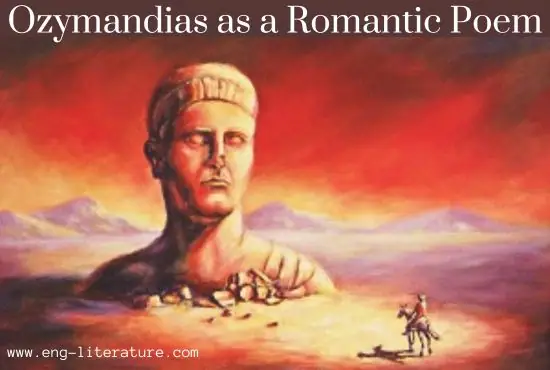Ozymandias as a Romantic Poem
Romanticism was a reaction against the Enlightenment, which emphasized reason and science, and sought to reclaim the emotions and imagination. Romanticism is characterized by a focus on individualism, nature, emotion, and the supernatural. Ozymandias is a romantic poem that reflects the Romanticism movement of the early 19th century. The poem is about the ruins of a statue of Ramses II, also known as Ozymandias, and how time has eroded its once-great empire. Shelley’s poem Ozymandias embodies many of romantic traits.
One of the central themes of Romanticism is the individual. The Romantic poets believed that the individual was important and should be celebrated. In Ozymandias, the statue of Ramses II is a symbol of power and dominance, but it has crumbled into ruins. The poem suggests that the individual’s power is ultimately transitory and fleeting. This idea is expressed in the final lines of the poem, where the narrator says,
“Nothing beside remains. Round the decay
Of that colossal wreck, boundless and bare
The lone and level sands stretch far away.”
Another theme of Romanticism is nature. The Romantics believed that nature was a source of inspiration and beauty. In Ozymandias, nature is depicted as a force that can overpower even the most powerful of men. The statue of Ramses II is “half sunk” in the sand, and the “colossal wreck” is surrounded by “lone and level sands.” This imagery suggests that nature has reclaimed the land and that human power is insignificant in the face of its majesty.
Emotion is another hallmark of Romanticism. The Romantics believed that emotions were essential to art and that they should be expressed freely. In Ozymandias, Shelley expresses a sense of awe and wonder at the ruins of the statue. The narrator describes the “vast and trunkless legs of stone” and the “shattered visage” of the statue with a sense of melancholy. This emotional response to the ruins is an example of the Romantic emphasis on feeling.
The supernatural is another important theme of Romanticism. The Romantics were fascinated by the unknown and the mysterious. In Ozymandias, the statue of Ramses II is a symbol of the supernatural. The statue is described as a “king of kings,” a title that suggests that Ramses II had god-like powers. The fact that his statue has crumbled into ruins suggests that even the supernatural is subject to the ravages of time.
One of the main themes of Ozymandias is the transitory nature of existence. The poem portrays the decay of power and greatness through the broken statue of Ozymandias in the desert, where only the pedestal and the legs of the statue remain. The inscription on the pedestal,
“My name is Ozymandias, King of Kings
Look on my Works, ye Mighty, and despair!”
suggests that the king was once a great ruler and conqueror who boasted about his achievements. However, the irony of the poem lies in the fact that the king’s pride and power have vanished, leaving only the ruins of his statue and the sands of time.
Another major theme of Ozymandias is the critique of human arrogance and pride. Shelley’s poem argues that human beings are too vain and proud to acknowledge their mortality and impermanence. The poem exposes the futility of human ambition and the frailty of human achievements. In this sense, Ozymandias is a romantic poem because it challenges the traditional view of human greatness and superiority, and it celebrates the beauty and mystery of nature and the universe.
Finally, Ozymandias is a perfect example of the Romantic use of imagery. The poem is full of vivid and powerful imagery that helps to create a sense of awe and wonder in the reader. The “vast and trunkless legs of stone” and the “shattered visage” of the statue are powerful images that stick in the mind. The description of the “lone and level sands” also creates a sense of emptiness and desolation, which is a common theme in Romantic literature.
“Ozymandias” is a quintessential Romantic poem that showcases Shelley’s mastery of language and his ability to evoke powerful emotions and ideas through his writing. The use of imagery, symbolism, and poetic devices creates a powerful and poignant poetic experience that speaks to the human condition. Ozymandias remains a timeless and thought-provoking poem that inspires readers to reflect on the fleeting nature of human grandeur and the enduring power of art and poetry.

Hello, Viewers! Besides being the Founder and Owner of this website, I am a Government Officer. As a hardcore literary lover, I am pursuing my dream by writing notes and articles related to Literature. Drop me a line anytime, whether it’s about any queries or demands or just to share your well-being. I’d love to hear from you. Thanks for stopping by!
